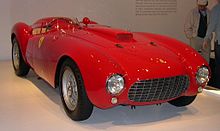Ferrari 375
The Ferrari 375 is a sports or racing sports car built between 1952 and 1955 in different variants by the Italian automobile manufacturer Ferrari . The name goes back to the rounded content of a single cylinder.
375 Indianapolis (1952/53)
375 America (1953-1955)
From 1951, Ferrari added larger models to its range in addition to the models with the smaller V12 developed by Gioacchino Colombo , which were powered by variants of the larger V12 engine developed by engineer Aurelio Lampredi based on the Colombo V12, mainly for racing. The main structural difference between the two V12 engine families, along with other changes, was the increased cylinder spacing in the Lampredi V12 from 90 to 108 mm, which allowed larger bore dimensions. In this model range, the 375 America presented at the Paris Salon in October 1953 replaced the earlier Ferrari 342 America .
The 4.1-liter V12 of the 342 was enlarged to 4523 cm³ for the 375 (bore × stroke: 84 × 68 mm) and made 221 kW (300 hp) at 6300 with three Weber 40DCF double carburetors and 8: 1 compression / min. Otherwise, the technology of the 375 America with box frame, front double wishbones, a rigid rear axle and drum brakes all around the other contemporary Ferrari models.
A total of around nine coupés with a Pinin Farina body, a Ghia coupé with three-color paint, as well as two coupés and a convertible by Vignale based on designs by Giovanni Michelotti , a total of around 13 examples of the 375 America were built on a wheelbase stretched to 2800 mm by 1955 .
375MM (1954)
The official presentation of the 375MM (Mille Miglia) in the 1954 season was preceded in the preseason by a 340MM equipped with a V12 enlarged to 4.5 liters, which failed at the 24 Hours of Le Mans after ten hours.
The works cars had a slightly different engine than the cars delivered to customers. In the works cars, the 80 mm bore (as in the 340) and the stroke of 74.5 mm (as in the contemporary Formula 1 engines from Ferrari) resulted in a displacement of 4494 cm³; the copies going on sale instead had dimensions of 84 × 68 mm.
In both cases, the output of the SOHC engine was given as 250 kW (340 hp) at 7000 rpm. The mixture preparation was done by three Weber 40IF / 4C or 42DCZ carburettors, the compression was 9.0: 1. These models also had box frames, drum brakes and a rigid rear axle.
A total of around 30 copies, ten series coupés and 16 series Spiders with Pinin Farina bodies, a Ghia coupe and a Vignale Spider were produced. In addition, Pinin Farina built a special coupé for actress Ingrid Bergman (chassis number 0456AM) and a special convertible for the King of Belgium (number 0488AM), the latter equipped with the 4.9-liter engine from the 375 Plus.
375 Plus (1954)
For the 375 Plus, a pure racing car, Ferrari combined the bore of the customer's 375MM (84 mm) with the stroke of the Formula 1 engines (74.5 mm), resulting in 4954 cm³. Equipped with three Weber 46DCF3 carburettors, these machines officially developed 243 kW (330 hp) at 6000 rpm. They were used exclusively in factory cars.
The five works cars built (all with Spider body by Pinin Farina) won Le Mans and the Carrera Panamericana in 1954 . A sixth car body by Scaglietti was sold in the USA.
literature
- Godfrey Eaton: The Complete Ferrari. Edited by Geoff Willoughby. Cadogan Books, London 1985, ISBN 0-947754-10-5 , pp. 51, 54-58 and 350f.



